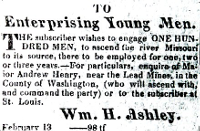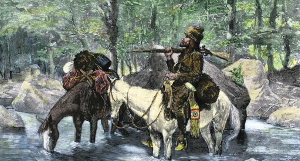William Henry Ashley: Famous Fur Trader and Explorer
William Henry Ashley was one of America's most famous fur trade operators. He employed some of the country's most famous Mountain Men in expeditions and explorations west in the first half of the 19th Century. Very little of Ashley's early life is known, and no photos of him have been reliably verified. He was born in Virginia in 1778. His family moved to Missouri sometime before 1802. He married Mary Able, and they lived on a plantation near what is now Cape Girardeau, Mo. In 1811, he was in Washington County, Mo., overseeing operations that made gunpowder and saltpeter. Also in the area and working in a lead mine was Andrew Henry, who would become Ashley's good friend and business partner. Ashley served as a justice of the peace for the St. Genevieve district for a time. He also joined the Missouri state militia and served in the War of 1812. He was made lieutenant colonel in 1814 and by 1819 had achieved the rank of colonel. Missouri became a state in 1820, and Ashley was elected as the state's first lieutenant governor, along with Gov. Andrew McNair. In 1822, Ashley had been promoted to the militia's highest rank, brigadier general. 
In that same year, Ashley joined with Andrew Henry to form the Rocky Mountain Fur Company. Ashley had moved to St. Louis in 1819 and found work in banking and real estate. On Feb. 13, 1822, Ashley placed an ad in the Missouri Gazette & Public Advertiser, a St. Louis newspaper, that sought a number of adventuresome men to travel west to take part in the burgeoning fur trade. A similar ad appeared in the St. Louis Enquirer two weeks later. Ashley and Henry benefited from a great many applicants, who became known as "Ashley's Hundred." Some of those became America's most famous Mountain Men; among those were Jim Bridger, Hugh Glass, Jedediah Smith, and Thomas Fitzpatrick. To facilitate the transportation of furs back east, Ashley and Henry followed the earlier example of the North West Company and set up an annual Rendezvous, a sort of open-air market that operated at the end of the trapping season; in exchange for furs, trappers could receive supplies for the next season. He attended two such rendezvous, in 1825 and 1826. 
The number of such expeditions rose. Ashley led several himself, including one that reached the Great Salt Lake and one that rediscovered the South Pass, which lent itself to explorers who traveled on the California Trail, the Mormon Trail, and the Oregon Trail. One led by Ashley, up the Missouri River, provoked an attack by members of the Arikara tribe, which resulted in the deaths of 24 of Ashley's men. In response, two groups of men, one of them Col. Henry Leavenworth and the 6th U.S. Infantry, converged on the Arikara villages, and the conflict escalated into what came to be called the Arikara War, the first instance of direct attack on Native Americans by soldiers of the U.S. Government. Other expeditions had misadventures. One of the first keelboats to go up the Missouri River sank, taking thousands of dollars' worth of provisions in it. In response, Ashley and Henry accompanied a resupply expedition and met at the junction of the Missouri River and the Yellowstone River, where they built Fort Henry. 
Ashley and Henry decided to abandon expeditions to Montana and to stop building trading posts and forts; the directive was then to allow the men that they employed to pick their own routes through the mountains and plains of the West. Ashley ran for governor in 1824 but lost that election, to Frederick Bates. At the same time, Henry sold his interest in the fur trading company, and Ashley's new partner was Jedediah Smith. Ashley led an expedition into the Rocky Mountains in 1825 that proved to be extremely profitable, netting him several thousand furs. That was his last expedition, and he sold the fur trading company to Smith and others in 1826. He married three times in all. His first wife died in 1821. His second marriage, to Eliza Christy, was in 1825. She died a few years later. He married Elizabeth Wilcox in 1832. He filled the vacant seat of Spencer Pettis, a member of the U.S. House of Representatives who had been killed in a duel, and then was re-elected twice. He stepped down in 1837 in order to run again for lieutenant governor. He didn't win. He died at age 59 of pneumonia on March 26, 1838. |
|
Social Studies for Kids
copyright 2002–2025
David White





